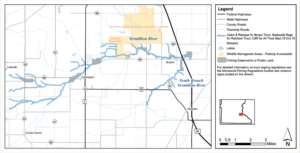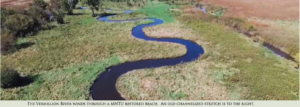Fishing the Vermillion River
Connecting with Big Metro Area Browns
Author: Matthew Doth
 Put your feet down anywhere in Minnesota, close your eyes and throw a stone; it is likely going to hit some fishable water. We have a wealth of places in this state for fishing walleye, pike, bass, muskie, you name it, and all within minutes of down- town Minneapolis and St. Paul. A little known river just as close as these other places offers the only Blue Ribbon trout water within a major metropolitan area in the entire country. The Vermillion River in Dakota County offers one of the best opportunities to catch one of the largest stream-resident wild brown trout that you can find in the entire Midwest. Not being traditional trout water, it can be a bit frustrating to try and figure it out. This article will help shave off a little of that learning curve time, and give a few pointers from my experience guiding and fishing this unique and amazing fishery.
Put your feet down anywhere in Minnesota, close your eyes and throw a stone; it is likely going to hit some fishable water. We have a wealth of places in this state for fishing walleye, pike, bass, muskie, you name it, and all within minutes of down- town Minneapolis and St. Paul. A little known river just as close as these other places offers the only Blue Ribbon trout water within a major metropolitan area in the entire country. The Vermillion River in Dakota County offers one of the best opportunities to catch one of the largest stream-resident wild brown trout that you can find in the entire Midwest. Not being traditional trout water, it can be a bit frustrating to try and figure it out. This article will help shave off a little of that learning curve time, and give a few pointers from my experience guiding and fishing this unique and amazing fishery.
Access is now better than ever on the Vermillion due to the state’s efforts in acquiring property along the river and the creation of several new Aquatic Management Areas. Over the past few years in cooperation with the state, Twin Cities Trout Unlimited (TCTU) has created miles of rehabilitated stream, as well as new habitat to harbor giant trout. When you combine habitat and the ability this river has to provide forage to trout, you end up with an incredible trophy stream. So then the question becomes how do you fish it?
I mentioned that the Vermillion is not a traditional trout stream. This stream is devoid of the numerous rock substrates, riffles and boulders that areas like southeastern Minnesota provide. The stream is not muddy, but it lacks main stream structure in most areas. For this reason, trout in the Vermillion are very bank related and tend to be vagabonds rather than homebodies. The “V,” as I like to call it, has a way of humbling, as well as frustrating you. There are plenty of locations that have deeper runs or pools, as well as plenty of cut banks and areas littered with wood. When you look at some of the TU restoration areas, you cannot help but think of how many trout are hiding in these stretches. It is these areas you will certainly want to concentrate on. Large fish live here and these areas produce. Here comes the frustrating part and time and time again these areas will have you questioning your sanity as you continue to offer up perfect casts and presentations with nothing happening. Many times early on fishing the Vermillion I have blindly stomped up stream, passing what I thought were marginal locations, only to spook off what was nothing less than a spectacularly huge trout. I have seen large trout in a foot and a half of water seemingly sunning themselves. It pays to fish everything on the Vermillion. Similar to muskie fishing you will want to cover water. Don’t work too fast of a pace, but also don’t linger too long. Every cast has potential.

The Vermillion has an abundance of forage and prey for trout. Spring provides a legion of leopard frogs, crayfish, and nymph opportunities for larger stoney patterns (think black colors here), as well as many scurrying mice in the grassland portions of the stream. Come late summer and early fall, you can add in armies of grasshoppers of all sizes up to the first frosts. There is a may fly hatch that will happen anywhere from mid-June to mid-July, it comes quick and ends fast. I have yet to hit it. My suggestion would be to leave the dry flies at home. I have spent a lot of time on this stream and have yet to witness a large trout take something off the top. Research shows that large brown trout, those at the 20 inch or larger range, have a diet that consists of 90% sh. This is very much true on the Vermillion. There is an abundance of minnow species that should be at the top of the list in your streamer box. The clear and number one choice for me is the emerald shiner. I love patterns with some teal glitter, along with a hint or tickle of peach or orange. I am not a fan of things that stand out too much so don’t go overboard. Trophy fish can be incredibly tight lipped and rather particular.
Other minnow patterns that should be part of the mix for the Vermillion are creek chubs, white suckers, madtoms, and red fin shiners. All of these species represent something that is worth chasing for a large brown. I would suggest studying some photos of these species and “matching the hatch” as we say. Don’t be afraid to throw patterns that are 4 to 5 inches long either, at all times of the year. Depending on the water level and pace of the flow, some forward weight to the fly may be necessary to get it down in the water column. I have seen fish that were very aggressive come three feet to hit a presentation, but as a rule I would say you want to be down to the half way mark of the water column for depth. The Vermillion does swell quickly with run off from heavier rain events, but it also tends to drop and clear rather well. It will come as no surprise that my best days have come with overcast low clouds, even with light rain and cool conditions. If it is possible to time your efforts for this kind of weather you are going to increase your odds at hookups. Even better would be to time it with a decreasing water level and increasing water clarity. Any day is a good day to fish, we all know that, and in the same respect I have caught large fish on those imperfect “blue bird” days as well.

Nothing improves ones chances on any stream like learning in the classroom of Mother Nature. Standing on the Vermillion and putting your own knowledge and time in is going to pay dividends. If there is anything I have learned about fishing the Vermillion, in a simple summary, it is this: cover ground, work everything that seems deep enough to hold a fish, use minnow patterns and throw something that is worth a big fat old brown to get off the couch to eat. Grab your 5 or 6 weight rod, a good 3X tippet and go into it with realistic expectations and some patience. The Vermillion is a very satisfying and unique river to fish. Yes, off in the distance you are likely to hear that occasional plane flying over into the Lindbergh Terminal, or cars rushing down Highway 52, but nowhere else in this great country will you find a trophy trout stream so close to home! Let me leave you with a reminder of how important this river is, how delicate a fishery it is, that our work here is not done, and that it is our responsibility to continue to protect and improve The “V”!
